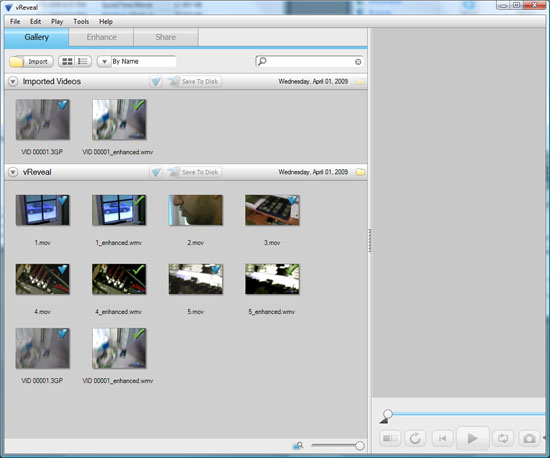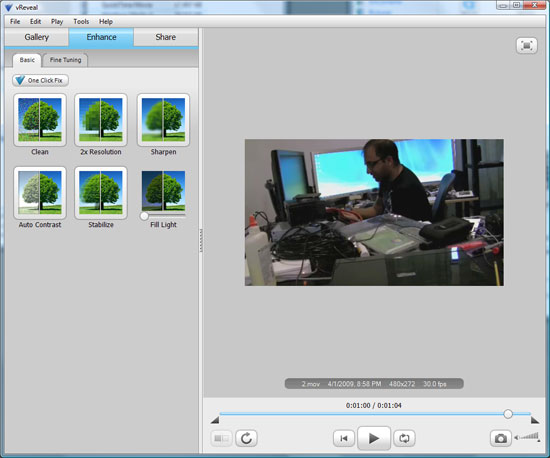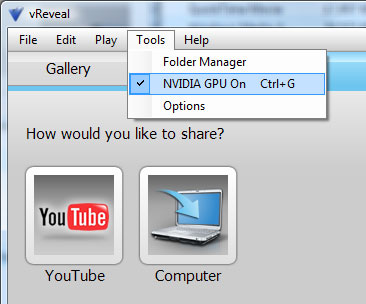ATI Radeon HD 4890 vs. NVIDIA GeForce GTX 275
by Anand Lal Shimpi & Derek Wilson on April 2, 2009 12:00 AM EST- Posted in
- GPUs
The Latest CUDA App: MotionDSP’s vReveal
NVIDIA had more slides in its GTX 275 presentation about non-gaming applications than it did about how the 275 performed in games. One such application is MotionDSP’s vReveal - a CUDA enabled video post processing application than can clean up poorly recorded video.
The application’s interface is simple:

Import your videos (anything with a supported codec on your system pretty much) and then select enhance.

You can auto-enhance with a single click (super useful) or even go in and tweak individual sliders and settings on your own in the advanced mode.
The changes you make to the video are visible on the fly, but the real time preview is faster on a NVIDIA GPU than if you rely on the CPU alone.

When you’re all done, simply hit save to disk and the video will be re-encoded with the proper changes. The encoding process takes place entirely on the GPU but it can also work on a CPU.
First let’s look at the end results. We took three videos, one recorded using Derek’s wife’s Blackberry and two from me on a Canon HD cam (but at low res) in my office.
I relied on vReveal’s auto tune to fix the videos and I’ve posted the originals and vReveal versions on YouTube. The videos are below:
In every single instance, the resulting video looks better. While it’s not quite the technology you see in shows like 24, it does make your videos look better and it does do it pretty quickly. There’s no real support for video editing here and I’m not familiar enough with the post processing software market to say whether or not there are better alternatives, but vReveal does do what it says it does. And it uses the GPU.
Performance is also very good on even a reasonably priced GPU. It took 51 seconds for the GeForce GTX 260 to save the first test video, it took my Dell Studio XPS 435’s Core i7 920 just over 3 minutes to do the same task.
It’s a neat application. It works as advertised, but it only works on NVIDIA hardware. Will it make me want to buy a NVIDIA GPU over an ATI one? Nope. If all things are equal (price, power and gaming performance) then perhaps. But if ATI provides a better gaming experience, I don’t believe it’s compelling enough.
First, the software isn’t free - it’s an added expense. Badaboom costs $30, vReveal costs $50. It’s not the most expensive software in the world, but it’s not free.
And secondly, what happens if your next GPU isn’t from NVIDIA? While vReveal will continue to work, you no longer get GPU acceleration. A vReveal-like app written in OpenCL will work on all three vendors’ hardware, as long as they support OpenCL.
If NVIDIA really wants to take care of its customers, it can start by giving away vReveal (and Badaboom) to people who purchase these high end graphics cards. If you want to add value, don’t tell users that they should want these things, give it to them. The burden of proof is on NVIDIA to show that these CUDA enabled applications are worth supporting rather than waiting for cross-vendor OpenCL versions.
Do you feel any differently?










294 Comments
View All Comments
SiliconDoc - Monday, April 6, 2009 - link
Well thanks for stomping the red rooster into the ground, definitively, after proving, once again, that what an idiot blabbering pussbag red spews about without a clue should not be swallowed with lust like a loose girl.I mean it's about time the reds just shut their stupid traps - 6 months of bs and lies will piss any decent human being off. Heck, it pissed off NVidia, and they're paid to not get angry. lol
tamalero - Sunday, April 5, 2009 - link
arggh, lots of typoos."Mirrors Edge's PhysX in other hand does show indeed add a lot of graphical feel. " should have been : Mirrors Edge's physx in other hand, does indeed show a lot of new details.
lk7600 - Friday, April 3, 2009 - link
Can you please die? Prefearbly by getting crushed to death, or by getting your face cut to shreds with a
pocketknife.
I hope that you get curb-stomped, f ucking retard
Shut the *beep* up f aggot, before you get your face bashed in and cut
to ribbons, and your throat slit.
papapapapapapapababy - Saturday, April 4, 2009 - link
Yes, i love you too, silly girl.lk7600 - Friday, April 3, 2009 - link
Can you please remove yourself from the gene pool? Preferably in the most painful and agonizing way possible? Retard
magnetar68 - Thursday, April 2, 2009 - link
Firstly, I agree with the articles basic premise that lack of convincing titles for PhysX/CUDA means this is not a weighted factor for most people.I am not most people, however, and I enjoy running NVIDIA's PhysX and CUDA SDK samples and learning how they work, so I would sacrifice some performance/quality to have access to these features (even spend a little more for them).
The main point I would like to make, however, is that I like the fact that NVIDIA is out there pushing these capabilities. Yes, until we have cross-platform OpenCL, physics and GPGPU apps will not be ubiquitous; but NVIDIA is working with developers to push these capabilities (and 3D Stereo with 3D VISION) and this is pulling the broader market to head in this direction. I think that vision/leadership is a great thing and therefore I buy NVIDIA GPUs.
I realize that ATI was pushing physics with Havok and GPGPU programming early (I think before NVIDIA), but NVIDIA has done a better job of executing on these technologies (you don't get credit for thinking about it, you get credit for doing it).
The reality is that games will be way cooler when the you extrapolate from Mirror's Edge to what will be around down the road. Without companies like NVIDIA out there making solid progress on executing on delivering these capabilities, we will never get there. That has value to me I am willing to pay a little for. Having said that, performance has to be reasonable close for this to be true.
JarredWalton - Thursday, April 2, 2009 - link
Games will be better when we get better effects, and PhysX has some potential to do that. However, the past is a clear indication that developers aren't going to fully support PhysX until it works on every mainstream card out there. Pretty much it means NVIDIA pays people to add PhysX support (either in hardware or other ways), and OpenCL is what will really create an installed user base for that sort of functionality.If you're a dev, what would you rather do: work on separate code paths for CUDA and PhysX and forget about all other GPUs, or wait for OpenCL and support all GPUs with one code path? Look at the number of "DX10.1" titles for a good indication.
josh6079 - Thursday, April 2, 2009 - link
Agreed.NVidia has certainly received credit for getting accelerated physics moving, but its momentum stops when they couple it to CUDA when offering it to discrete graphics cards outside of the GeForce family.
Hrel - Thursday, April 2, 2009 - link
Still no 3D Mark scores, STILL no low-med resolutions.Thanks for including the HD4850, where's the GTS250??? Or do you guys still not have one? Well, you could always use a 9800GTX+ instead, and actually label it correctly this time. Anyway, thanks for the review and all the info on CUDA and PhysX; pretty much just confirmed what I already knew; none of it matters until it's cross-platform.
7Enigma - Friday, April 3, 2009 - link
3DMark can be found in just about every other review. I personally don't care, but realize people compete on the Orb, and since it's just a simple benchmark to run it probably could be included without much work. The only problem I see (and agree with) is the highly optimized nature both Nvidia and ATI put on the PCVantage/3DMark benchmarks. They don't really tell you much about anything IMO. I'd argue they not only don't tell you about future games (since to my knowledge no (one?) games have ever used an engine from the benchmarks), nor do they tell you much between cards from different brands since they look for every opportunity to tweak them for the highest score, regardless of whether it has any effect in realworld performance.What low-med resolution are you asking for? 1280X1024 is the only one I'd like to see (as that's what I and probably 25-50% of all gamers are still using), but I can see why in most cases they don't test it (you have to go to low end cards to have an issue with playable framerates on anything 4850 and above at that resolution). Xbitlabs' review did include 1280X1024, but as you'll see, unless you are playing Crysis:Warhead, and to a lesser extent Farcry2 with max graphics settings and high levels of AA you are normally in the high double to triple digits in terms of framerate. Any resolution lower than that, you've got to be on integrated video to care about!